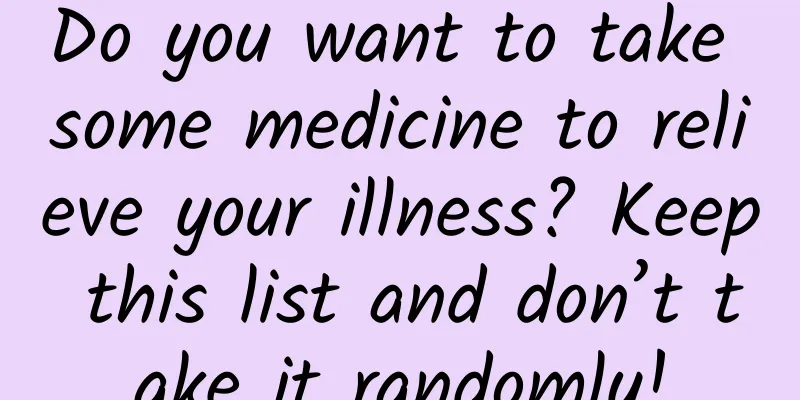Do you want to take some medicine to relieve your illness? Keep this list and don’t take it randomly!

|
Nowadays, everyone is always accompanied by various drugs Many people's first reaction when they are sick is Take some medicine to "press it down" If you can’t hold it down, increase the amount and frequency Even if you are not sick Don't take some medicine or health products I always feel insecure. But the old saying goes All medicines are poisonous, so don’t take them randomly! If you "eat wrong" May cause liver damage Image source: Weibo screenshot In the past decade or so, the incidence of drug-induced liver injury has increased significantly and has become one of the common causes of liver disease in China. Image source: Photo Network Drug-induced liver injury, also known as drug-induced liver disease, generally refers to liver damage induced by taking various prescription drugs, health products, traditional Chinese medicine, etc. It is a common adverse drug reaction. Image source: Photo Network This drug-induced liver damage may further develop into cirrhosis , and in severe cases may lead to acute liver failure or even death ! There are currently more than a thousand drugs that can be clearly linked to drug-induced liver injury. Common drugs that cause drug-induced liver injury include: Traditional Chinese medicine: Polygonum multiflorum, Psoralea corylifolia, Dioscorea bulbifera, Bupleurum chinense, Tripterygium wilfordii, Notoginseng, Coriolus mulberry leaf, etc. Dietary supplements: vitamin A, retinoic acid (isotretinoin, acitretin), retinoids, etc.; Cardiovascular system drugs: fenofibrate, atorvastatin, captopril, propranolol, mexiletine, amiodarone, etc.; Nonsteroidal anti-inflammatory drugs: ibuprofen, acetaminophen (paracetamol), aspirin, etc.; Anti-tuberculosis drugs: rifampicin, isoniazid, pyrazinamide, etc.; Antibiotics: penicillin, cephalosporin, tetracycline, sulfonamides, etc.; Anti-tumor drugs: cytarabine, methotrexate, thalidomide, tamoxifen, taxanes, lomustine, etc. Note! It does not mean that taking the above drugs will definitely lead to drug-induced liver injury . Its pathogenesis is usually related to the drug dosage . Image source: Photo Network Generally speaking, as long as you follow your doctor's instructions and take your medication, the risk of drug-induced liver injury is relatively low. However, if you feel that taking one vitamin pill a day is not enough and you insist on taking 8 pills, a healthy person may end up suffering from drug-induced liver damage. Image source: Photo Network Of course, there are special cases. Some people with special constitutions may suffer from severe drug-induced liver damage no matter how much of a certain drug they take. This requires us to identify some symptoms in time to see if drug-induced liver damage has occurred. If you are taking the above-mentioned drugs and have no underlying liver disease, but have the following symptoms, be careful of the possibility of drug-induced liver injury! ● Nausea, bloating, and loss of appetite; ● The skin and eyes turn yellow, and the whole body turns into a "Minion"; ● Fever, weakness, itchy skin and rash; ● Light or clay-colored stools; ● Severe drug-induced liver injury can also cause mental symptoms such as drowsiness, temperament changes, and impaired consciousness. If you experience any of the above symptoms, it is recommended that you seek medical attention immediately! Image source: Photo Network If you suspect that a drug is the cause, you should stop taking the drug under the advice of a professional doctor . Usually, the symptoms will be relieved after stopping the drug. For certain drugs that carry a high risk of side effects after discontinuation, if you cannot stop taking them immediately, please consult your doctor to consider changing medications, or use liver-protecting drugs at the same time to reduce the burden on the liver. Elderly people who have multiple chronic diseases and take multiple therapeutic drugs often need to take medication for life. In addition, the poor metabolic function of the elderly affects the metabolism of drugs in the body, and the risk of drug-induced liver injury also increases . Image source: Photo Network In addition, people with a history of drug allergies, liver and kidney dysfunction, long-term alcohol consumption, nutritional disorders, and newborns are at greater risk of drug-induced liver injury than ordinary people . Image source: Photo Network This group of people should be more careful when taking medicine, follow the doctor's advice, use the medicine reasonably, and prevent drug-induced liver injury. 1. Do not take medicine randomly: take medicine according to the course and dosage prescribed by the doctor, and do not believe in folk remedies with unclear sources, unknown ingredients, and uncertain efficacy; eliminate irrational use of medicines. Taking several medicines together may not cure the disease quickly, and due to the interaction between drugs, it may also cause more serious liver damage. 2. Take medications strictly as directed by the doctor: For patients with a history of drug-induced liver damage in their family or who have experienced liver damage themselves, if they must take certain medications with potential liver-damaging effects, they must take medications strictly as directed by the doctor. 3. Regularly monitor liver function: Patients who take hepatotoxic drugs for a long time should remember to monitor liver function regularly. 4. Do not take health supplements at will: Do not think that dietary supplements and health supplements are all good without any harm. The drugs mentioned above have potential liver damage and should be used with caution, especially for middle-aged and elderly people. Do not take health supplements at will; Statement: This article is a medical-related educational popular science article. It does not involve specific treatment methods or medical behaviors and cannot replace hospital visits. Author Zhong Shitong, Class of 2020, Five-year Clinical Medicine Program, West China School of Clinical Medicine Xiao Weirui, 2020, five-year clinical medicine student at West China School of Clinical Medicine Yu Zihuan, Class of 2020, Five-Year Clinical Medicine Program, West China School of Clinical Medicine Liang Meiting, Class of 2020, Five-year Clinical Medicine Program, West China School of Clinical Medicine Chen Shiqi, Class of 2020, Five-Year Clinical Medicine Program, West China School of Clinical Medicine Zhang Yuyang, Class of 2020, Five-year Clinical Medicine Program, West China School of Clinical Medicine Experts who reviewed this article References 1. Drug-Induced Liver Injury Prevention and Treatment Technical Committee of China Pharmaceutical Biotechnology Association, Drug-Induced Liver Disease Group of Chinese Society of Hepatology. Chinese Guidelines for the Diagnosis and Treatment of Drug-Induced Liver Injury (2023 Edition)[J]. Chinese Journal of Hepatology, 2023, 31(4): 355-384. 2. Chinese Medical Association, Chinese Medical Association Journal, Chinese Society of Gastroenterology, et al. Primary diagnosis and treatment guidelines for drug-induced liver injury (2019)[J]. Chinese Journal of General Practitioners, 2020,19(10):868-875. 3. Ge Junbo, Xu Yongjian, Wang Chen, et al. Internal Medicine (9th Edition)[M]. People's Medical Publishing House, 2018:401-404. 4. Fontana RJ. Pathogenesis of idiosyncratic drug-induced liver injury and clinical perspectives. Gastroenterology. 2014;146(4):914-928. 5. Xie Xinhe, Zhao Ruiling. Research progress in clinical diagnosis of drug-induced liver injury[J]. Medical Review, 2019,25(20):4044-4048+4054. 6. European Association for the Study of the Liver. Clinical Practice Guideline Panel: Chair:; Panel members; EASL Governing Board representative:. EASL Clinical Practice Guidelines: Drug-induced liver injury. J Hepatol. 2019;70(6):1222-1261. Content Production Edit: 100% sweet Map: Eastern Zhou Dynasty |
>>: The popularity of the “20-minute park effect” may be related to the origin of human beings?
Recommend
Analysis of Internet Financial Product Operation Strategy
The main product model of Internet finance is rel...
How does an APP build a user operation system?
I believe that my colleagues in the Internet indu...
Smells so good! Pitcher plants stop eating bugs and start eating feces, and they're actually doing better!
Due to their cute shapes and unique habits, carni...
Progress bar! It's actually! Fake! What's the point of it?
In 1984, Jobs, who was only 29 years old, decided...
What’s new about live streaming sales?
First, the format of live streaming has become mo...
Don’t Make These Mistakes in Mobile Menu Design
[[132830]] When we want to make user navigation o...
The world's second self-healed person appears! How far are we from conquering AIDS?
December 1 is the 34th World AIDS Day. Recently, ...
These 10 behaviors may seem fun, but they are actually very harmful to your health!
Everyone has some little hobbies in life that mak...
Tencent Advertising Game Industry July Buying Volume Monthly Report & Product Dynamics
This article shares with you Tencent’s July adver...
What causes bad taste in mouth? How to solve it!
The most embarrassing thing in life is: when you ...
Lin Sien·"Whole Brain Parenting" Intensive Reading Class
Lin Sien·"Whole Brain Parenting" Intens...
Intel leads the way in the "big adventure" of autonomous driving. What are the chances of BATH accelerating and surpassing others?
Intel, which has pulled the fuse, is igniting a b...
5 dimensions to create true “native advertising”
People watch what they want to see, and sometimes...
Weibo Fans Advertising and Charging Standards!
1. Introduction to Fantong What is Fantong? To pu...
The latest news on oil price adjustment on April 15, 2022: How much will it be reduced? Attach details
Since the beginning of this year, oil prices in m...









